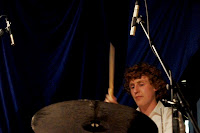 It was a thoughtful gesture. Conductor Nicholas Milton reminded the audience, before the Canberra Symphony Orchestra’s first concert of its annual series, to turn on their mobiles after the concert. Effective and wry. This is family, I thought, and we’re part, if only second cousins. Second cousins because we don’t attend every event, but like a family picnic, we enjoy it immensely when we get there. It’s a generous wing of the family that puts on this event. This concert had an overture (Beethoven’s Egmont overture), a concerto (Beethoven’s Piano concerto no. 3 in C minor Op.37) and a symphony (Tchaikovsky’s Pathetique Symphony No 6 in B minor Op.74). It’s like having a lamb spit and endless grog laid on. And the cousins all came along to this one. They are performing this concert on two nights but attendance was such that the Llewellyn had opened the dress circle.
It was a thoughtful gesture. Conductor Nicholas Milton reminded the audience, before the Canberra Symphony Orchestra’s first concert of its annual series, to turn on their mobiles after the concert. Effective and wry. This is family, I thought, and we’re part, if only second cousins. Second cousins because we don’t attend every event, but like a family picnic, we enjoy it immensely when we get there. It’s a generous wing of the family that puts on this event. This concert had an overture (Beethoven’s Egmont overture), a concerto (Beethoven’s Piano concerto no. 3 in C minor Op.37) and a symphony (Tchaikovsky’s Pathetique Symphony No 6 in B minor Op.74). It’s like having a lamb spit and endless grog laid on. And the cousins all came along to this one. They are performing this concert on two nights but attendance was such that the Llewellyn had opened the dress circle.




 It’s not a big orchestra, but the volume was loud enough when it needed to be. I thought the strings were a bit quiet against the rest but I actually enjoyed this: the flutes and bassoons and the rest were unusually clear in intent and tone, and the brass once had me jumping from my seat. The funding for our local orchestra is none too generous, so I can understand the limits on size. But I felt they did a grand job with these works. It was a popular program and I guessed not too tortuous, but they sounded great: fine time, fine intonation, fine interpretation. I found it impressive and eminently entertaining. The audience clapped between movements a few times, but I quite like that (clapping only at the end is a 20th century affectation). I like it when people express their involvement and it spurs on the performers. Nicholas dealt with cheers after the third movement of the Tchaikovsky really well. I think they were chuffed but the orchestra segued smoothly into the final movement with considerable ease and good will.
It’s not a big orchestra, but the volume was loud enough when it needed to be. I thought the strings were a bit quiet against the rest but I actually enjoyed this: the flutes and bassoons and the rest were unusually clear in intent and tone, and the brass once had me jumping from my seat. The funding for our local orchestra is none too generous, so I can understand the limits on size. But I felt they did a grand job with these works. It was a popular program and I guessed not too tortuous, but they sounded great: fine time, fine intonation, fine interpretation. I found it impressive and eminently entertaining. The audience clapped between movements a few times, but I quite like that (clapping only at the end is a 20th century affectation). I like it when people express their involvement and it spurs on the performers. Nicholas dealt with cheers after the third movement of the Tchaikovsky really well. I think they were chuffed but the orchestra segued smoothly into the final movement with considerable ease and good will.As for the music, that was great. Beethoven is passionate, but more importantly, he seems so unforced to my ears. I never feel he’s thrown ideas together; everything melds one line to another. It’s obvious why he’s so admired. The Egmont was loud and impressive and bombastic from the start. (As PlayerOfPiano says in a comment on YouTube: “Forget Metallica, Beethoven invented headbanging”). The 3rd piano concerto was satisfying, even if I sometimes lost detail in the piano lines. But all the flourishes of piano and the tonal contrast of a concerto are a pleasure. Gerard Willems was the pianist and he played it with ease, presumably as an old friend. And I’m liking the romantics more. Tchaikovsky was not so inevitable in composition as Beethoven, but I enjoyed numerous passages. The famous line in the first movement, of course, but also the waltz-like feel played strangely in 5/4 in the second movement that was sometimes dance-like, other times syncopated and a devil to count, the power and excitement of the penultimate movement and the forlorn feels throughout and especially in the final movement.
Lovely. I can only leave with a refreshing joy. Our local CSO is a little gem. The Canberra Symphony Orchestra performed Beethoven’s Egmont Overture, Beethoven’s Piano Concerto no. 3 in C minor Opus 37 and Tchaikovsky’s Symphony no. 6 in B minor (Pathetique) as the first concert of its 2012 season at the Llewelly Hall with Nicholas Milton (conductor) and Gerard Willems (piano).


















































